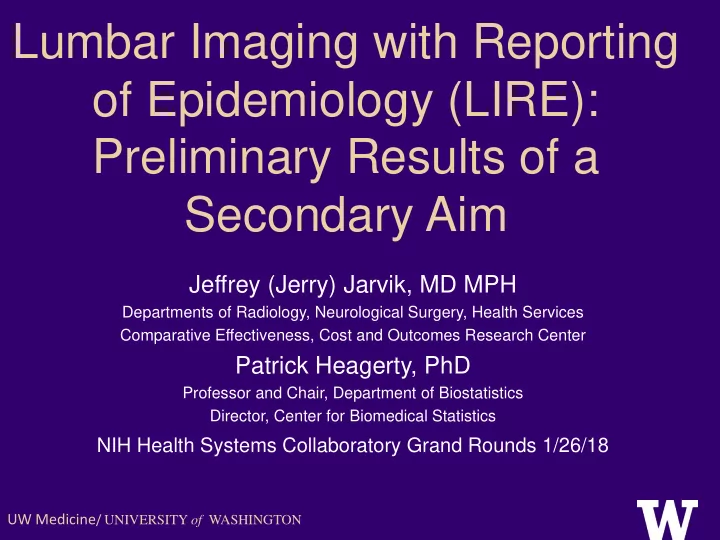

Lumbar Imaging with Reporting of Epidemiology (LIRE): Preliminary Results of a Secondary Aim Jeffrey (Jerry) Jarvik, MD MPH Departments of Radiology, Neurological Surgery, Health Services Comparative Effectiveness, Cost and Outcomes Research Center Patrick Heagerty, PhD Professor and Chair, Department of Biostatistics Director, Center for Biomedical Statistics NIH Health Systems Collaboratory Grand Rounds 1/26/18 UW Medicine / UNIVERSITY of WASHINGTON
Acknowledgements • NIH: UH2 AT007766-01; UH3 AT007766; P30 AR072572 • AHRQ: R01HS019222-01; 1R01HS022972-01 • PCORI: CE-12-11-4469 Disclosures (Jarvik) • Physiosonix : ultrasound company, Founder/stockholder • Healthhelp : utilization review, consultant • UpToDate: Section Editor • Evidence Based Neuroimaging Diagnosis and Treatment: Springer, Co-Editor
Talk Outline • Brief review of study goals/design • Progress to date • Subsequent MR/CT imaging through 90 days • Next steps
LIRE (pronounced leer ) from the French verb, ‘to read’.
Background and Rationale • Lumbar spine imaging frequently reveals incidental findings • These findings may have an adverse effect on: – Subsequent healthcare utilization – Patient health related quality of life
Disc Degeneration in Asx
Primary Hypothesis • For patients referred from primary care, inserting prevalence benchmark data in lumbar spine imaging reports will reduce overall spine-related healthcare utilization as measured by spine-related relative value units (RVUs)
Secondary Hypotheses • We also hypothesized that the intervention would decrease: – Subsequent cross-sectional imaging (MR/CT) – Opioid prescriptions – Spinal injections – Surgery
Retrospective Pilot Results: Subsequent Imaging Within 1 Yr 12/166 P=0.14 OR*=0.22 1/71 * Adjusted for imaging severity
Published this week …
Intervention Text The following findings are so common in normal, pain-free volunteers, that while we report their presence, they must be interpreted with caution and in the context of the clinical situation. Among people between the age of 40 and 60 years, who do not have back pain, a plain film x-ray will find that about: • 8 in 10 have disk degeneration • 6 in 10 have disk height loss Note that even 3 in 10 means that the finding is quite common in people without back pain.
Randomization • Cluster (clinic) • Stepped wedge (one way crossover)
Stepped Wedge RCT
Participating Systems Name # Primary Care Clinics # PCPs (Randomized) (Randomized) Kaiser Perm. N. 21 2,349 California Henry Ford 26 187 Health System, MI Kaiser 19 365 Permanente of Washington Mayo Health 34 400 System Total 100 3,301
Talk Outline • Brief review of study goals/design • Progress to date • Subsequent MR/CT imaging through 90 days • Next steps
LIRE: Enrollment
Demographics
Patient age at index image
Female
Race
Hispanic Ethnicity
Imaging Modality
Dealing with Complexities: Timing O Time
Dealing with Complexities: Timing O C Time
Dealing with Complexities: Timing O C F Study Time Day 0
Dealing with Complexities: Timing Index Test O C F (Xray or MRI) Study Time Day 0
Outcome Definition (MR/CT) O C F Study Study Day 0 Day 90
Outcome Definition (MR/CT) O C F O C F Study Study Day 0 Day 90
Outcome Definition (MR/CT) O C F O C F O C F Study Study Day 0 Day 90
Outcome Definition (MR/CT) C F O O C F O C F O C F Study Study Day 0 Day 90
Outcome Definition (MR/CT) C F O O C F O C F O C F C F O Study Study Day 0 Day 90
Ordered after index and completed within 90 days O C F Site A Site B Xray 12.6% 13.5% MR 1.9% 3.2% { O C F O C F Study Study Day 0 Day 90
Ordered before index and completed between 0-90 days C F O Site A Site B O C F Xray 2.9% 1.5% MR 0% 0.1% Study Study Day 0 Day 90
Ordered 0-90 days after index but finalized after 90 days O C F Site A Site B Xray 0.7% 0.3% MR 0.2% 0.2% C F O Study Study Day 0 Day 90
Time between MR Order and Completion
Intervention Adherence
Stepped Wedge RCT
Talk Outline • Brief review of study goals/design • Progress to date • Subsequent MR/CT imaging through 90 days • Next steps
These Are Preliminary Results • Results are preliminary since we continue careful and deliberate data cleaning, an iterative process • Have completed this process for 2 of 4 sites for secondary outcome: subsequent CT or MR by 90 days
Cumulative Incidence of MR/CT Imaging Over All Waves
Cumulative Incidence of MR/CT by Intervention/Control Group XRay MR XRay MR Control Intervention
X-ray Cohort Control Intervention (I-C)
MR Cohort Control Intervention (I-C)
Talk Outline • Brief review of study goals/design • Progress to date • Subsequent MR/CT imaging through 90 days • Next steps
Analysis in Progress • Fixed effects: age, gender, site, 6- month time point, clinic size, and baseline comorbidity • GEE and NLMIXED • Separate models for XR and MR
Lessons Learned
Some Key Lessons Learned • Prior – Keep intervention as simple as possible – Minimize burden on system partners • Current – Big data sets are complex – Understanding complexities iterative process that takes time
Key People • • Katie James, PA, MPH, Director Rick Deyo, MD, MPH- OHSU • • Brian Bresnahan, PhD- Health Econ Dan Cherkin, PhD- KPWA • • Bryan Comstock, MS- Biostats Karen Sherman, PhD- KPWA • • Janna Friedly, MD- Rehab Heidi Berthoud, KPWA • • Laurie Gold, PhD- Radiology Brent Griffith, MD- HFHS • • Patrick Heagerty, PhD- Biostats Dave Nerenz, PhD- HFHS • • Larry Kessler, PhD- HSR Dave Kallmes, MD- Mayo • • Danielle Lavallee, Pharm D, PhD Patrick Luetmer, MD- Mayo • • Eric Meier, MS- Biostats Andy Avins, MD, MPH- KPNC • Nancy Organ, BA- Statistics • Kari Stephens, PhD- Informatics • Judy Turner, PhD- Psychol/Psych • Sean Rundell, DPT, PhD • Zachary Marcum, PharmD, PhD • Katherine Tan, PhD Candidate, Biostats
Why Pragmatic Trials Are Important
Time between Order and Completion for MR and XR
MR/CT Rates by Age and Gender
Recommend
More recommend